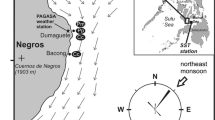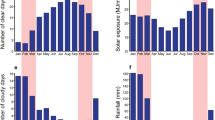Abstract
Fecundity and abundance of Acropora palifera and the abundance of other scleractinians were compared at two reefs in the Huon Gulf, Papua New Guinea. While temperature and salinity were similar at both reefs, turbidity and sedimentation were higher on one of the reefs. A negative correlation was found between fecundity of A. palifera and three factors: depth, turbidity and sedimentation rate. There was also a negative correlation between coral cover and water transparency and sedimentation. The results suggest that high rates of sedimentation and low transparency depress fecundity of A. palifera, and limit the depth distribution and reduce the abundance of this species and other scleractinians. Lower fecundity in February and March was correlated with higher water temperatures. It is suggested that coral reproduction can be used as a biological indicator of stress on coral reefs.
Similar content being viewed by others
References
Anon (1980) Papua New Guinea tide predictions, 1980. Department of Transport, Hydrographic Section
Babcock RC (1984) Reproduction and distribution of two species of Goniastrea (Scleractinia) from the Great Barrier Reef Province. Coral Reefs 2:187–195
Bak RP (1978) Lethal and sublethal effects of dredging on reef corals. Mar Pollut Bul 9:14–16
Cochran WG, Cox GM (1957) Experimental designs. Wiley, New York
Coles SL, Jokiel PL (1977) Effects of temperature on photosynthesis and respiration in hermatypic corals. Mar Biol 43:209–216
Coles SL, Jokiel PL (1978) Synergistic effects of temperature, salinity and light on the hermatypic coral Montipora verrucosa. Mar Biol 49:187–195
Coles SL, Jokiel PL, Lewis CR (1976) Thermal tolerance in tropical versus subtropical Pacific reef corals. Pac Sci 30:159–166
Connell JH (1973) Population ecology of reef-building corals. In: Jones OA, Endean R (eds) Biology and geology of coral reefs, vol 2: Biology I. Academic Press, New York London, pp 205–245
Delvoye L (1982) Aspects of sexual reproduction in some Caribbean scleractinia. Caribbean Marine Biological Institute, Curacao, NA
Dodge RE, Vaisnys JR (1977) Coral populations and growth patterns: responses to sedimentation and turbidity associated with dredging. J Mar Res 35:715–730
Fadlallah YH (1983) Sexual reproduction development and larval biology in scleractinian corals. A review. Coral Reefs 2:129–150
Gerking SD (1980) Fish reproduction and stress. In: Ali MA (ed) Environmental physiology of fishes. Plenum Press, New York, pp 569–587
Harriott VJ (1983a) Reproductive ecology of four scleractinian species at Lizard Island, Great Barrier Reef. Coral Reefs 2:9–18
Harriott VJ (1983b) Reproductive seasonality, settlement, and postsettlement mortality of Pocillopora damicornis (Linnaeus), at Lizard Island, Great Barrier Reef. Coral Reefs 2:151–157
Harrison PL, Babcock RC, Bull GD, Oliver JK, Wallace CC, Willis BL (1984) Mass spawning in tropical reef corals. Science 223:1186–1189
Hull CH, Nie NH (1981) SPSS update 7–9: new procedures and facilities for releases 7–9 McGraw-Hill, New York
Johannes RE (1975) Pollution and degradation of coral reef communities. In: Wood EJF, Johannes RE (eds) Tropical marine pollution. Elsevier, Amsterdam, pp 13–51
Jokiel PL, Guinther EB (1978) Effects of temperature on reproduction in the hermatypic coral Pocillopora damicornis. Bull Mar Sci 28:786–789
Kinne O (1963) The effects of temperature and salinity on marine and brackish water animals. I. Temperature. Oceanogr Mar Biol 1:301–340
Kojis BL (1984) Reproductive ecology of some hermatypic corals in the West Pacific. PhD thesis, University of Queensland
Kojis BL, Quinn NJ (1980) Mode and timing of sexual reproduction in some members of the hermatypic coral Faviidae. Am Zool 20:819
Kojis BL, Quinn NJ (1981a) Aspects of sexual reproduction and larval development in the shallow water hermatypic coral, Goniastrea australensis (Edwards and Haime 1857). Bull Mar Sci 31:558–573
Kojis BL, Quinn NJ (1981b) Factors to consider when transplanting hermatypic corals to accelerate regeneration of coral reefs. Proceedings of the 1981 Environmental Engineering Conference, Townsville, Australia, pp 183–187
Kojis BL, Quinn NJ (1982a) Reproductive strategies in four species of Porites (Scleractinia). Proc 4th Int Coral Reef Symp 2:145–151
Kojis BL, Quinn NJ (1982b) The reproductive ecology of two faviid corals (Coelenterata, Scleractinia). Mar Ecol Prog Ser 8:251–255
Lasker HR (1980) Sediment rejecting by reef corals and the role of behaviour and morphology. J Exp Mar Biol Ecol 47:77–88
Loya Y (1975) Possible effects of water pollution on the community structure of Red Sea corals. Mar Biol 29:177–185
Loya Y (1976a) Effects of water turbidity and sedimentation on the community structure of Puerto Rican corals. Bull Mar Sci 26:450–466
Loya Y (1976b) Recolonization of Red Sea corals affected by natural catastrophes and man-made perturbations. Ecology 57:278–289
Loya Y, Rinkevich B (1979) Abortion effect in corals induced by oil pollution. Mar Ecol Prog Ser 1:77–80
Marshall SM, Orr AP (1931) Sedimentation of Low Isles Reef and its relation to coral growth. Sci Rep Great Barrier Reef Exped 1928–1929
Mayer AG (1918) Ecology of the Murray Island coral reef. Carnegie Inst Washington Publ 213:3–48
Moorsel WNM van (1983) Reproductive strategies in two closely related stony corals (Agaricia, Scleractinia). Mar Ecol Prog Ser 13:273–283
Neudecker S (1982) Growth and survival of scleractinian corals exposed to thermal effluents at Guam. Proc 4th Int Coral Reef Symp 1:173–180
Nie NH, Hull GH, Jenkins JG, Steinbrenner K, Bent DH (1975) Statistical package for the social sciences, 2nd edn. McGraw-Hill, New York
Quinn NJ (1980) Analysis of temporal changes in fish assemblages of Serpentine Creek, Queensland, Australia. Environ Biol. Fish 5:117–133
Yap HT, Gomez ED (1982) Growth of Acropora pulchra (Brook) in Bolinao, Pangasinan, Philippines. Proc 4th Int Coral Reef Symp 2:207–213
Author information
Authors and Affiliations
Rights and permissions
About this article
Cite this article
Kojis, B.L., Quinn, N.J. Seasonal and depth variation in fecundity of Acropora palifera at two reefs in Papua New Guinea. Coral Reefs 3, 165–172 (1984). https://doi.org/10.1007/BF00301961
Accepted:
Issue Date:
DOI: https://doi.org/10.1007/BF00301961




